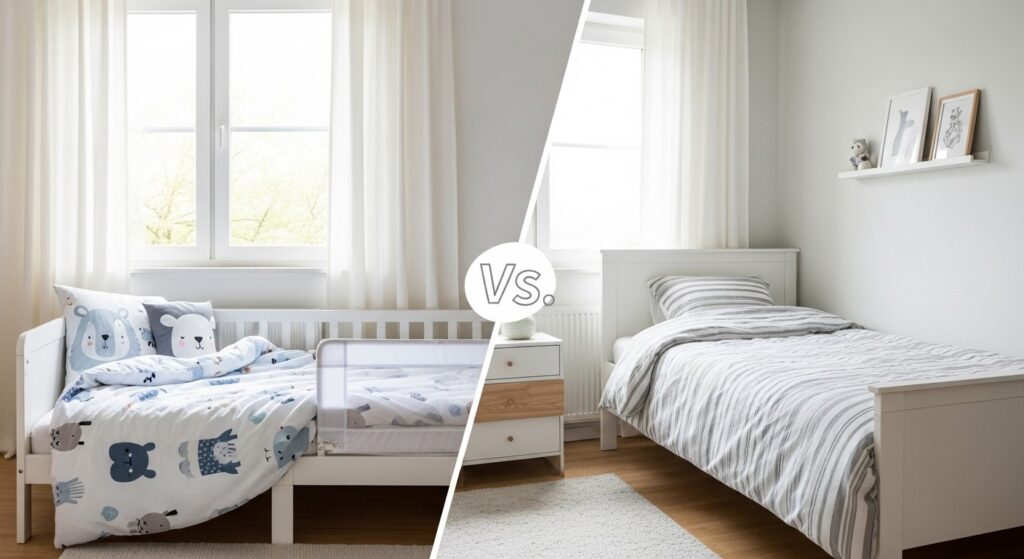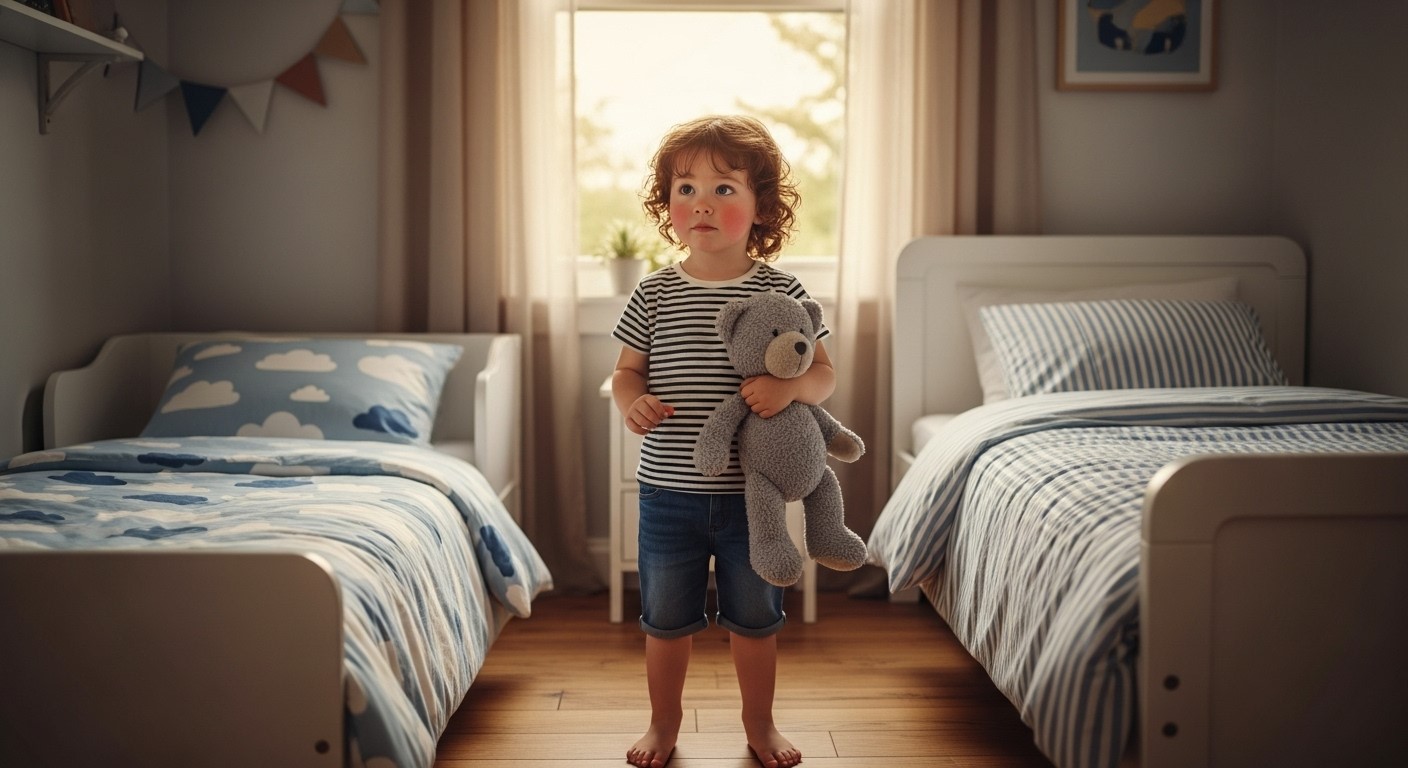Junior Bed vs Twin Bed: The Definitive Guide to Your Child’s First Bed
Choosing your child’s first “big kid bed” is an exciting milestone, but it comes with a critical decision:
should you invest in a small, transitional junior bed or jump straight to a long-term twin bed?
The answer isn’t the same for every family, and getting it right can save you money, space, and a lot of headaches.
As an expert who has guided countless parents through this choice, I can tell you this:
the decision boils down to a trade-off between short-term safety and convenience versus long-term value and comfort.
A junior bed (also known as a toddler bed) is the ultimate transitional step.
It’s small, low to the ground, and uses the same crib mattress your child already knows.
A twin bed is the classic, full-sized bed that can last from preschool through high school, offering more space and comfort.
This guide will provide a comprehensive, head-to-head comparison, covering everything from mattress size to hidden costs, so you can make the most informed decision for your child and your home.

At-a-Glance Comparison: The Bottom Line Up Front
| Feature | Junior / Toddler Bed | Twin Bed |
| Mattress Size | ~28″ x 52″ (Standard Crib Mattress) | 38″ x 75″ (Standard Twin Mattress) |
| Footprint | Compact; ideal for small or shared rooms. | Takes up significantly more floor space. |
| Safety | Superior built-in safety. Low height and included guardrails. | Higher off the ground; requires separate guardrails. |
| Age Range | Ideal for 18 months to 4-5 years. | Suitable from age 3 through the teenage years. |
| Initial Cost | Lower. You reuse the crib mattress and bedding. | Higher. Requires a new frame, mattress, and bedding. |
| Long-Term Value | Poor. It’s a temporary purchase that will be outgrown. | Excellent. A one-time purchase that lasts 15+ years. |
| Comfort | Firm. Crib mattresses are designed for infant safety, not comfort. | Superior. A huge variety of comfortable mattress options. |
The Deep Dive: A Head-to-Head Analysis
Let’s break down the factors that truly matter when you’re standing in the store (or browsing online).
1. Size & Space: The Most Obvious Difference
This is a game-changer, especially for smaller homes.
- Junior/Toddler Beds: These are specifically designed to be compact. The frames are built to hold a standard toddler crib-size mattress (~28″ x 52″). A toddler bed takes up substantially less space, making it perfect for preserving precious floor space for play.
- Twin Beds: A twin bed is a major step up in size. The twin-size mattress alone is 38 inches wide by 75 inches long, and the frame adds several inches to that. While a twin bed provides more space for your child to stretch out, it can easily dominate a small bedroom, leaving little room for anything else.
Expert Takeaway: If your child’s room is small, a toddler bed is the clear winner for space management.
2. Safety & Ease of Use: A Parent’s Top Priority
For a young toddler, especially a restless sleeper, safety is non-negotiable.
- Junior/Toddler Beds: These are purpose-built for safety. They are usually much lower to the ground, meaning a fall results in a small bump, not an injury. Crucially, they almost always have built-in safety rails, providing a secure, enclosed feeling that’s reassuring for both kids and parents.
- Twin Beds: A standard twin bed is higher, creating a greater fall risk. You must purchase and install separate guardrails to make it safe for a young child. Interestingly, some parents on forums like Reddit point out that getting off a twin bed is much easier for some toddlers—they can sit and pivot their legs to the floor, whereas the very low toddler bed might require a “roll-out” maneuver.
Expert Takeaway: For out-of-the-box safety and peace of mind, the junior/toddler bed is unmatched.
3. Mattress & Comfort: The Overlooked Factor
This is where the long-term perspective really comes into play.
- Junior/Toddler Beds: They use crib mattresses, which are very firm by design to reduce SIDS risk. While safe, they are not particularly comfortable for a growing 3 or 4-year-old.
- Twin Beds: The leap in comfort is enormous. Twin mattresses are much more comfortable than toddler bed mattresses. They differ in width, length, and, most importantly, in thickness and materials (memory foam, hybrid, etc.). A quality mattress can improve sleep, which is why many parents feel a twin works so much better. This is also the size you’ll need when your child is approaching the weight limit for their toddler bed.
Expert Takeaway: A twin bed offers vastly superior comfort that will support your child’s sleep for years.
4. Cost & Longevity: The “Pay Now or Pay Later” Debate
- Junior/Toddler Beds: These are usually cheaper upfront. You can find a fun toddler bed for a boy (cars, superheroes) or for a toddler girl (princesses, unicorns) at a low price. The biggest saving comes from reusing your crib mattress and bedding.
- Twin Beds: This is a higher initial investment. You’re buying a frame, a quality mattress, and all-new, larger bedding. However, the most common advice from seasoned parents is to “save the money and go straight for the twin.” A junior bed is a temporary solution you’ll have to replace in 2-3 years, making it an “extra” purchase in the long run.
Expert Takeaway: The junior bed wins on immediate cost. The twin bed wins on long-term financial sense and value.
The Smart Alternative: Why Parents Love the Twin Floor Bed
There is a brilliant compromise that gives you the best of both worlds: the floor bed.
Instead of choosing between a toddler frame and a twin frame, you buy a quality twin mattress and place it directly on the floor.
Why this is the best first big kid bed:
- Ultimate Safety: It’s even lower than a toddler bed. A fall is impossible.
- Long-Term Value: You’ve already purchased the twin mattress that will last for years.
- Spacious Comfort: Your child gets all the room of a twin bed right away.
- Phased Cost: You can buy the twin bed frame later, when your child is older and you’re ready for the expense.
This toddler bed vs. floor bed with a twin mattress debate almost always ends with the floor bed as the preferred solution for parents focused on both safety and practicality.
Frequently Asked Questions (FAQ)
1. What’s the difference between a “Junior Bed” and a “Toddler Bed”?
In the US, these terms are mostly interchangeable and refer to a bed that uses a crib-sized mattress. Warning: Brands like IKEA sell a specific “junior bed” size that is longer than a toddler bed and requires its own special mattress. Always check dimensions before buying.
2. At what age is a child ready for a bed?
Most children transition between 18 months and 3.5 years. The key sign is safety: when they start trying to climb out of their crib, it’s time to move them.
3. How do I make a twin bed safe for a 2-year-old?
- Install Guardrails: Use one or two long, secure guardrails.
- Push it Against a Wall: Place the bed in a corner to eliminate two open sides.
- Use a Low-Profile Frame: Choose a bed frame that sits closer to the ground.
- Create a Soft Landing: Place a plush rug or floor cushions next to the bed.
4. What about bedding?
Toddler bed bedding is the same as crib bedding. For a twin bed, you’ll need to purchase a new set of sheets, pillows (once age-appropriate), and a comforter. This adds to the overall cost but also offers a fun way to style their new bedroom twin bed.
Final Verdict: Which Bed Is Right for Your Family?
Choose a JUNIOR / TODDLER BED if…
- Safety is your absolute #1 concern, and you want a secure, ready-to-go solution.
- Your child’s bedroom is very small, and every inch of play space counts.
- Your budget is tight right now, and reusing the crib mattress is a financial necessity.
- Your child seems nervous about a big bed, and the cozy, familiar size would be more comforting.
Choose a TWIN BED (or a Twin Floor Bed) if…
- You value long-term investments and prefer to buy once and be done.
- Comfort is a high priority, and you want to give your child the best possible sleep surface.
- You have adequate space in the bedroom.
- Your child is confident and tall for their age and would benefit from the extra room to grow.
Ultimately, both paths lead to a happy child in a “big kid bed.” By weighing these factors, you can feel confident you’re not just buying a piece of furniture, but making the perfect choice for your child’s next chapter.

